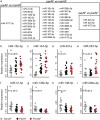MicroRNAs in atrial fibrillation target genes in structural remodelling
- PMID: 37833432
- PMCID: PMC10697892
- DOI: 10.1007/s00441-023-03823-0
MicroRNAs in atrial fibrillation target genes in structural remodelling
Abstract
We aim to elucidate how miRNAs regulate the mRNA signature of atrial fibrillation (AF), to gain mechanistic insight and identify candidate targets for future therapies. We present combined miRNA-mRNA sequencing using atrial tissues of patient without AF (n = 22), with paroxysmal AF (n = 22) and with persistent AF (n = 20). mRNA sequencing previously uncovered upregulated epithelial to mesenchymal transition, endothelial cell proliferation and extracellular matrix remodelling involving glycoproteins and proteoglycans in AF. MiRNA co-sequencing discovered miRNAs regulating the mRNA expression changes. Key downregulated miRNAs included miR-135b-5p, miR-138-5p, miR-200a-3p, miR-200b-3p and miR-31-5p and key upregulated miRNAs were miR-144-3p, miR-15b-3p, miR-182-5p miR-18b-5p, miR-4306 and miR-206. MiRNA expression levels were negatively correlated with the expression levels of a multitude of predicted target genes. Downregulated miRNAs associated with increased gene expression are involved in upregulated epithelial and endothelial cell migration and glycosaminoglycan biosynthesis. In vitro inhibition of miR-135b-5p and miR-138-5p validated an effect of miRNAs on multiple predicted targets. Altogether, the discovered miRNAs may be explored in further functional studies as potential targets for anti-fibrotic therapies in AF.
Keywords: Atrial fibrillation; Fibrosis; MicroRNA; Structural remodelling; Transcriptome sequencing.
© 2023. The Author(s).
Conflict of interest statement
Joris R. de Groot is supported by research grants through his institution from Abbott, Atricure, Boston Scientific, Bayer, Daiichi Sankyo, Johnson&Johnson and Medtronic Servier and received speaker/consultancy fees from Atricure, Bayer, Daiichi Sankyo, Johnson&Johnson and Medtronic outside the submitted work. Antoine H.G. Driessen is a consultant for Atricure. The other authors report no disclosures.
Figures






References
-
- Ayyanathan K, Peng H, Hou Z, Fredericks WJ, Goyal RK, Langer EM, Longmore GD, Rauscher FJ. The Ajuba LIM domain protein is a corepressor for SNAG domain-mediated repression and participates in nucleocytoplasmic shuttling. Cancer Res. 2007;67:9097–9106. doi: 10.1158/0008-5472.CAN-07-2987. - DOI - PubMed
-
- Bagci H, Sriskandarajah N, Robert A, Boulais J, Elkholi IE, Tran V, Lin ZY, Thibault MP, Dubé N, Faubert D, Hipfner DR, Gingras AC, Côté JF. Mapping the proximity interaction network of the Rho-family GTPases reveals signalling pathways and regulatory mechanisms. Nat Cell Biol. 2020;22:120–134. doi: 10.1038/s41556-019-0438-7. - DOI - PubMed
-
- Bang C, Batkai S, Dangwal S, Gupta SK, Foinquinos A, Holzmann A, Just A, Remke J, Zimmer K, Zeug A, Ponimaskin E, Schmiedl A, Yin X, Mayr M, Halder R, Fischer A, Engelhardt S, Wei Y, Schober A, Fiedler J, Thum T, Swynghedauw B, Barry S, Townsend P, Hill J, Olson E, Oka T, Komuro I, Takeda N, Kakkar R, Lee R, Fredj S, Bescond J, Louault C, Potreau D, LaFramboise W, Hunter M, Hergenreider E, Pegtel D, Valadi H, Ekstrom K, Bossios A, Sjostrand M, Lee J, Lotvall J, Halkein J, Wu L, Belasco J, Zhao Y, Thum T, Thum T, Tijsen A, Matkovich S, Ganesan J, Wang K, Zhang S, Weber J, Baxter D, Galas D, Arroyo J, Denzer K, van Eijk M, Kleijmeer M, Jakobson E, de Groot C, Geuze H, Raposo G, Kosaka N, Iguchi H, Yoshioka Y, Takeshita F, Matsuki Y, Ochiya T, Ucar A, Kioka N, Ueda K, Amachi T, Kakimoto Y, Cheng H, Mittelbrunn M, Chiba M, Kimura M, Asari S, Katzmann D, Babst M, Emr S, van Niel G, Porto-Carreiro I, Simoes S, Raposo G, Janowska-Wieczorek A, Segura E, Guerin C, Hogg N, Amigorena S, Thery C, Cocucci E, Racchetti G, Meldolesi J, Morelli A, Tian T, Wang Y, Wang H, Zhu Z, Xiao Z, Wong C, Zhang X, Azhar G, Wei J, Yang K, Yang X, Yuan K, Shan S, Czech B, Ghildiyal M, Xu J, Seitz H, Weng Z, Zamore P, Okamura K, Liu N, Lai E, Janssen H, Wang R, Thery C, Amigorena S, Raposo G, Clayton A, Vaz C, Anders S, Huber W. Cardiac fibroblast–derived microRNA passenger strand-enriched exosomes mediate cardiomyocyte hypertrophy. J Clin Invest. 2014;124:2136–2146. doi: 10.1172/JCI70577. - DOI - PMC - PubMed
MeSH terms
Substances
Grants and funding
LinkOut - more resources
Full Text Sources
Medical

